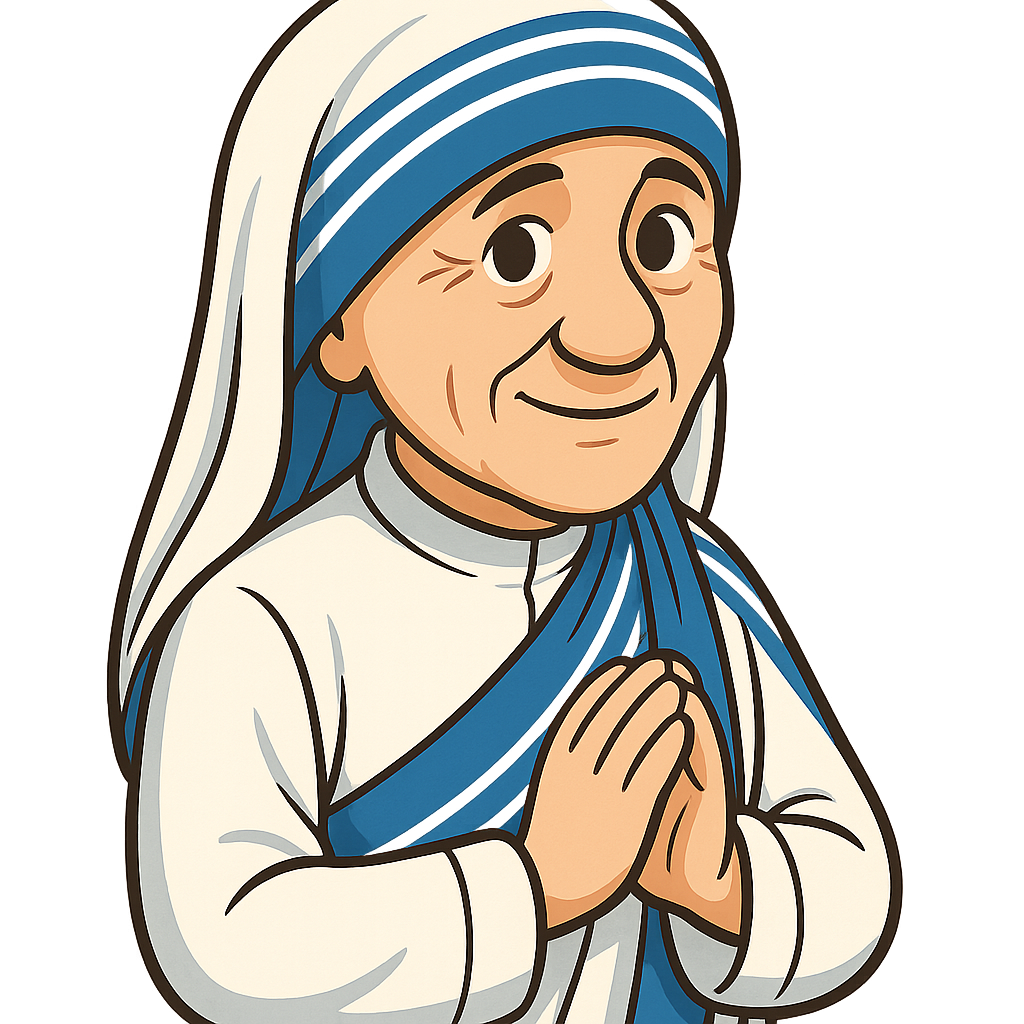Mother Teresa
My story begins not as Mother Teresa, but as a little girl named Anjezë Gonxhe Bojaxhiu. I was born on August 26, 1910, in Skopje, a city that was then part of the Ottoman Empire. My family was Albanian, and our home was filled with love, faith, and a deep sense of community. My father, Nikola, was a respected businessman, and my mother, Dranafile, was a kind and devout woman who taught me my most important lessons. She would often say, “My child, never eat a single mouthful unless you are sharing it with others.” She would invite the poor of the city to dine with us, and if there wasn’t enough food for everyone, she would tell me, “Some of these people have only us.” When I was just eight years old, my father died suddenly, and our world changed. But my mother’s faith never wavered, and she raised my siblings and me with strength and compassion. I was fascinated by stories of missionaries who traveled to faraway lands to help people. By the time I was 12, I felt a deep certainty in my heart that my life was meant for God, to serve others. This feeling grew stronger each year. In 1928, at the age of 18, I made the most difficult decision of my life: I said goodbye to my mother and my home to travel to Ireland and join the Sisters of Loreto. I knew I would likely never see my family again, but my calling to serve was a light I had to follow.
From Ireland, I boarded a ship for a long sea voyage to India, a country that would become my home for the rest of my life. When I arrived in 1929, the sights, sounds, and smells were a world away from everything I had known. I took my first religious vows and chose the name Sister Mary Teresa, after St. Thérèse of Lisieux, who was known for doing small things with great love. For nearly two decades, I lived and worked in Calcutta, which is now called Kolkata. I was a teacher, and later the principal, at St. Mary’s School for girls. I truly loved my work and my students. The school was a peaceful place, a sanctuary surrounded by high walls. My life there was orderly and safe. But just outside those walls, I saw a reality that shook me to my core. I saw people living in extreme poverty, suffering from hunger and sickness on the streets. I saw children with no one to care for them and elderly people left alone to die. The stark contrast between my quiet life in the convent and the immense suffering just beyond its gates weighed heavily on my heart. I loved my students, but I began to feel a deep, unsettling feeling that I was not doing enough. The faces of the poor haunted me, and a new question began to form in my mind: what was my true purpose?
Everything changed on September 10, 1946. I was on a train heading to Darjeeling for my annual retreat when I experienced something I can only describe as a “call within a call.” It was a message, as clear to me as if it were spoken aloud, telling me to leave the convent and dedicate myself completely to helping the poorest of the poor by living among them. This was a terrifying and radical idea. It meant leaving the security of the Loreto order and stepping into a world of uncertainty with nothing but my faith. It took two long years to receive permission from my superiors and the Vatican. Many people thought it was a foolish and dangerous plan. In 1948, I finally walked out of the convent gates for the last time, wearing not the traditional habit I had worn for years, but a simple white cotton sari with a blue border, like the poorest women of India. I had no money, no building, and no plan—only a mission. I started by finding children in the slums and teaching them to read and write by drawing letters in the dirt with a stick. Soon, some of my former students came to join me. In 1950, with a small group of just 12 sisters, we received official permission to start our own community: the Missionaries of Charity.
Our mission was simple: to serve those who had been forgotten—the hungry, the naked, the homeless, the crippled, the blind, the lepers, all those people who felt unwanted, unloved, uncared for throughout society. What began in a small, rented room in Calcutta grew beyond my wildest dreams. Over the decades, the Missionaries of Charity spread across the globe. We opened homes for the dying, orphanages, and clinics on every continent. In 1979, I was awarded the Nobel Peace Prize. I accepted it not for myself, but in the name of the poor, to give a voice to those who had none. I told the world that the greatest poverty is not hunger, but the feeling of being unloved. My life came to an end on September 5, 1997, but the work continued through the thousands of sisters who had joined our cause. My final message to you is the one I lived by: “Not all of us can do great things. But we can do small things with great love.” You do not need to be rich or powerful to make a difference. A smile, a kind word, or a helping hand is enough to bring light into someone’s life. Every act of love, no matter how small, makes the world a better place.
Reading Comprehension Questions
Click to see answer
